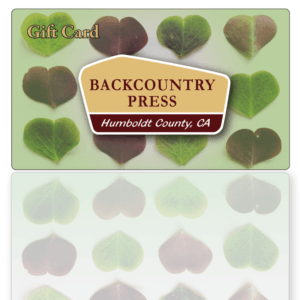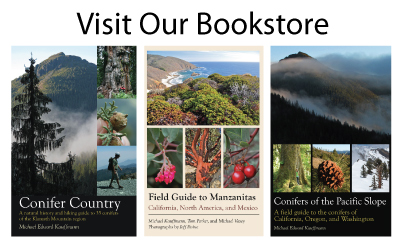Length: 3.6 – 4.8 miles. See also McCann Ferry to Camp Grant Flats (Extras)
Total ascent: 320 feet
Elevations: 190 – 350 feet
Type: 0% loop
Land management: County of Humboldt
Fee: none
Access constraints: Under high water conditions, the ferry may be the only way to cross. The ferry operates M – S from 7 – 11 am; 1 – 5 pm and 9 – 11 am and 1 – 3 pm on Sunday. Be careful not to stray off the county road as this is an area of reputed marijuana cultivation.
Dogs: yes
Bicycles: yes
Horses: yes
Restrooms: none (although you will pass a public restroom in the Founders Grove parking lot 0.1 mile after turning onto the Dyerville Loop Road).
Description: McCann was once big enough to have a school and a store. All that remains is a diffuse community of small farms and homes. For most of the year, it is possible to cross the Eel on an elevated concrete low-water bridge. During those times when the Eel overtops the bridge, the only option becomes the nearby McCann ferry. Starting from the very unpretentious ferry terminus, this walk crosses the bridge and follows the east side road for about a mile and a half (farther is possible). The road rises above the Eel and provides excellent views up and down the river.
Getting there: Proceed south on US 101 for 42.3 miles. Take Exit 663 (South Fork/Honeydew/CA 254). Take a sharp left at the stop sign and an immediate right turn on CA 254. After crossing over a bridge of the South Fork of the Eel River, turn at the first left, the Dyerville Loop Road (0.2 mile). Follow the Dyerville Loop Road for 6.3 miles as it twists along the west side of the main stem of the Eel River. Turn left into the McCann Ferry parking area, which should have ample parking even if the ferry is in operation. Approximate driving time, 1 hour and 5 minutes.
The route: From the McCann Ferry parking lot, you should first take a brief walk around the accessible path and landing area. Then turn south on the road that will soon reach the concrete low water bridge (0.3). After crossing the bridge, the main route veers right (a smaller road veers left and services several homes downriver) and soon re-enters the trees on the east side of the Eel River floodplain. The road climbs past several homes and screening fences (0.9) offering river views up and down the Eel. The road rises higher with more views passing an intersection with a gravel road that heads off to the left (1.3). Stay right. You will reach a cattle guard and a reasonable turnaround point (1.8). Soon the main road deteriorates until it too is more gravel than bitumen. Stay right at the next intersection (2.2). The road ends at a turnaround (2.4). These are somewhat remote reaches of the Emerald Triangle and it is prudent to not stray from the road.
Extras. Camp Grant option. The paved Dyerville Loop Road (right turn from the Ferry parking lot) winds northwest through the forest and along Thompson Bluff for several miles before dropping back down onto open, broad Camp Grant Flat. The route crosses the floodplain to a Seventh Day Adventist Camp and a NWP railroad overpass (3.7), where the road begins to climb again as it re-enters forest. Although the road is narrow at times and has limited shoulders, there is minimal traffic. Some of my walking colleagues prefer this direction. Turn around any time to shorten the walk.
Camp Grant, once the site of a short-lived Union Army regiment, became a logging outpost and staging area during the construction of the Northwestern Pacific Railroad through the early 20th century. Early settlers coming to Eureka from the south following the strenuous trails over Island Mountain (Bell Springs Road) and along the current Dyerville Loop Road passed Camp Grant on their way north.

